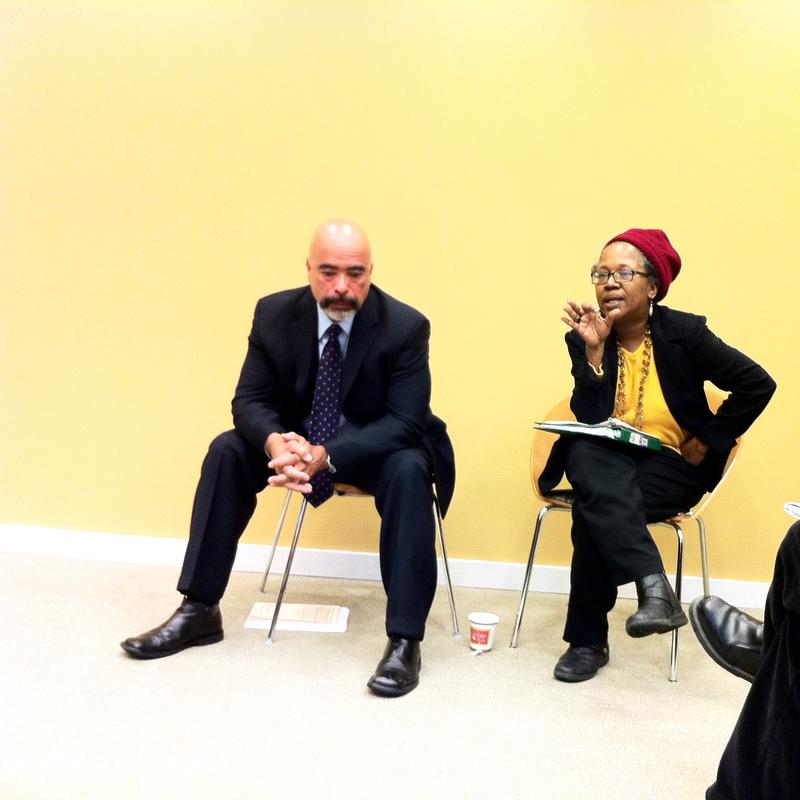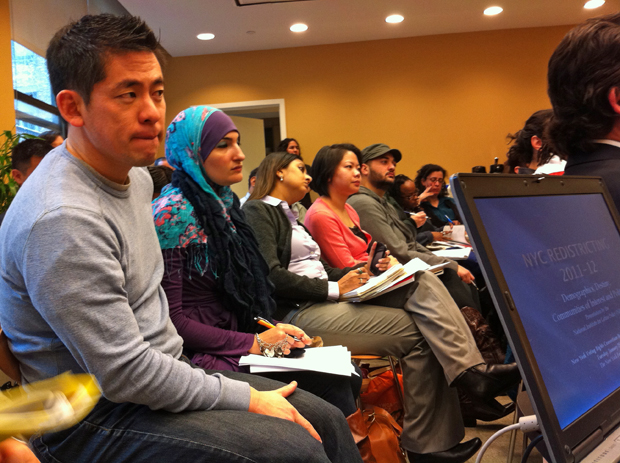
Minority communities are arming themselves with mapping software, census data, and the intricacies of the Voting Rights Act to ensure that they get their say when districts are redrawn this year. They're determined to elect representatives in Congress, the state Legislature, and on the local level who will vote with their concerns in mind.
The Voting Rights Act, which aims to prevent discrimination against minorities, dates from 1965, but three of New York's five boroughs are still monitored by the Justice Department for compliance. "There are lots of majority minority districts in New York City. The whole city is a majority minority district! But there are a lot of white people who are in office, who are not from our communities," said Esmeralda Simmons of the Center for Law and Social Justice at Medgar Evers College/CUNY, whose bluntness is notorious.
It may sound wonky, but the battle for representation is very real, and minority communities leaders at a redistricting briefing this week at the New York Foundation got heated about voter dillution tactics like "cracking," "packing," and "tacking." Oh, and you must determine your CVAP.
Say what? Let me break that lingo down for you.
CRACKING: When an area's residents who have similar characteristics—i.e. same ethnic group and tendency to vote for a particular party—are divided into various districts. This dilutes their ability to function as voting bloc to elect a candidate of their choice and makes it harder to get representatives to care about their issues.
PACKING: Jamming as many people with the same characteristics into the smallest number of districts possible—so that their power will be restricted. For example, the redistricting commission could choose to draw a district that is 90 percent African American, rather than drawing two different districts that are each at least 45 percent African American.
TACKING: Particularly favored by gerrymanderers, this is the tactic that makes very funny looking districts. Mapmakers reach out and grab an area that is nominally contiguous and tack it on to their district of choice. It is also often used to draw a politician's home in (or out) of a district so that they can (or cannot) run for office there. A few years ago, City Council member Hakeem Jeffries alleged this was done to his district in Fort Greene.
CVAP: Citizen Voting Age Population.

A diverse crowd at the redistricting briefing hosted at the New York Foundation on January 25, 2011.
Cracking, packing and tacking have historically been used to intentionally disenfranchise communities. But it's also a natural occurence as demographics shift, like in Queens, where the growing South Asian community now feels cracked—they are split between five different state assembly tracts.
At the redistricting briefing, community leaders (whose accents represented the diverse voices making up the New York City population) were frank about what they want to change, and energetically discussed strategies.
One challenge at the top of the list was to make sure that in diverse immigrant communities, there'd be a sufficient number of citizens who can actually vote.
"From the point of view of a political party who wants to protect its incumbent, you want to reassure them that the reelection is based on a sufficient number of citizen voters. If you have a district that is now redrawn so that 80 percent of them are non-citizens, what good is it for that power base?" said Jackson Chin from the non-profit organization Latino Justice.
"Some people like it that way," Simmons pointed out.
At the briefing, there was no beating around the bush—attendees were outspoken about solidifying themselves as a political consituency.
"I'm guessing you have to draw a district that's between 60 and 75 percent Latino to get to a CVAP of 51, 52 percent. Depending on what part of the city you're talking about, and the longevity of the group you're talking about—if it's a Dominican community that's been here a long time you might have a higher number of citizens. So what you're really drawing a district for is effective voting opportunities," said Juan Cartagena, General Counsel at the Community Service Society.
But it's complicated, not only because of citizenship status. There are certain minority groups that are invested in ensuring that their districts won't change, while there are others who are trying to completely redraw the lines. When a speaker asked what groups were planning to create their own maps to lobby the redistricting commission with, about 10 people raised their hands, ranging from Arab American to African American to Chinese American. Angelo Falcon, executive director of the National Institute for Latino Policy, suggested people try to find what they have in common, outside of their ethnic identity.
All of these groups must contend with the existing power structure, which is largely content with the status quo—it got them elected, after all.
"They're fine with having the same 2,000 people reelect them every time. They're not interested in having 4,000 additional people, it could undermine their power," said Chin.
Linda Sarsour, director of the Arab American Association of New York, said she's unhappy that her community, centered in Bay Ridge, is wrapped up in the same district as Staten Island. In response, Glenn D. Magpantay of the Asian American Legal Defense and Education Fund asked her, "The question is, who do you want to go to? If you're in Bay Ridge, do you want Borough Park and the Jewish community? Do you want to go to the Chinese, in Bensonhurst? What's worse, or better?"
It's also a balancing act to manage the subtle rivalries within American-defined ethnic categories, which tend to sweep century-old distinctions under the table. "When I talk about a pan-South Asian community, that in itself is controversial," said John Albert, an Indian American lobbying for redistricting in Queens to get the South Asian population some representation. Albert said he has to convince a fragmented population that unity is important in politics. "I want people to be proud of their own communities, but I also want them to be realistic about their political potential."
Leaving the event, it was clear that the battle over redistricting is deeper than the war to draw Republican or Democrat-favored districts. It's a delicate political science, in which every special interest group throws a spice into the draftsman's crockpot, hoping that their ingredient will tip the stew to their choice flavor.
"Some people call it gerrymandering, we call it empowering our communities," said Falcon.